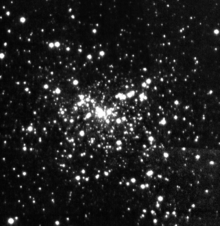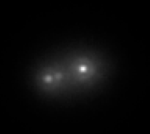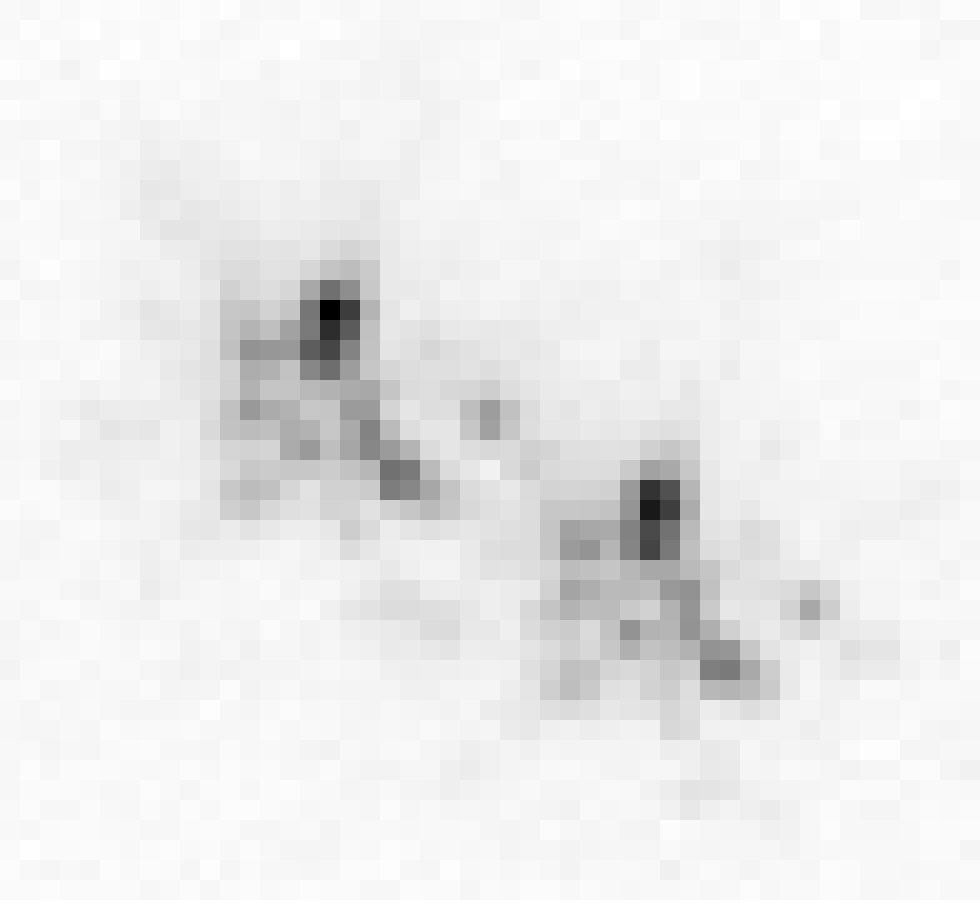Lucky Imaging

Lucky Imaging is a variant of speckle interferometry and is mainly used in astrophotography . The technology behind it is in a camera that allows sufficiently short exposure times. The exposure times are sufficiently short if the optical disturbances caused by the earth's atmosphere do not change or change only minimally in this period of time.
In lucky imaging with exposure times of typically a few tens of milliseconds, the best, for example 10% of all images are selected from many - often several thousand - individual images. These are marked at a reference point and a final image is generated from them using the shift-and-add method. The result leads to an image with improved resolution compared to an image exposed for the same length of time.
The fact that the optical disturbances caused by the earth's atmosphere randomly fluctuate between minor and strong disturbances allows the selection of precisely those recordings with the least optical disturbances; hence the associated designation Lucky Imaging for the restriction to the successful recordings that takes place during image creation.
Explanation
Images from space that are recorded with ground-based telescopes are significantly more blurred than images from space telescopes of the same size. The reason for this is the optical turbulence caused by the earth's atmosphere. In addition to the blurring, this also leads to scintillation or the twinkling of stars that can be observed with the naked eye. The resulting blurring, also known as seeing in astronomy , is in the range of arc seconds. The theoretically achievable resolution, more precisely angular resolution, of modern large telescopes, on the other hand, lies in the visible spectral range at a few tens of milli-arcseconds, which is two orders of magnitude better. Lucky imaging is one of several methods to reduce the blurring caused by the atmosphere. By selecting the best single images with short exposure from a longer image sequence, it is possible to reach the diffraction limit of a 2.5 m telescope. This is less than 100 milli-arcseconds in the visible spectral range.
Double star ξ Boötes ( bear guardian ) taken with the Nordic Optical Telescope on May 13, 2000 and the lucky imaging method. The so-called Airy disks around the stars are created by diffraction at the telescope aperture.
Illustration of the principle
The following picture sequence shows the functional principle of Lucky Imaging. From a series of 50,000 images, taken at a speed of approx. 40 images per second, five images with different exposure times were generated. In addition, the series of images shows at the very beginning a single image with poor optical quality, which was not selected for the lucky imaging method, and then a single image with very high optical quality which was selected. All images show the object with the 2MASS ID J03323578 + 2843554. North is up and east is left.
 |
Single image with poor optical quality is not selected for the lucky imaging process. | |
 |
Single image with high optical quality is selected for the lucky imaging process. | |
 |
The picture shows the average of all 50,000 individual shots, corresponding to a long exposure of 21 minutes (50,000 / 40 seconds). This is the seeing limited image. The object is a bit elongated. The full width at half maximum (FWHM) of the seeing disk is approx. 0.9 arc seconds. | |
 |
The image shows the mean value of all 50,000 individual images, but each image was shifted to a specified reference value before averaging. This corresponds to an image stabilization of the long-exposure picture. More details of the object are already recognizable through this process. | |
 |
The image shows the mean of the 25,000 best individual images after the brightest pixel in all images has been moved to the same reference position. The 50% selection makes further details, three point sources, recognizable. | |
 |
The image shows the average of the 5,000 (10%) best individual images after the brightest pixel in all images has been moved to the same reference position. The surrounding halo is less pronounced and a diffraction ring around the brightest object is clearly visible. | |
 |
The image shows the mean of the 500 (1%) best individual images after the brightest pixel in all images has been moved to the same reference position. The surrounding halo is suppressed even more clearly. The signal-to-noise ratio of the brightest source is the highest in this picture compared to all previous ones. |
The difference between the seeing limited image (3rd image from above) and the lucky imaging result, in which the 1% best individual images were selected, is remarkable: a triple system can be observed on the latter and the other Image cannot be recognized. The brightest component in the west (on the pictures on the right) is a star of the spectral class M4V with a magnitude of V = 14.9. This star was used as a reference source for lucky imaging; This means that the brightest pixel has been shifted by this point to a previously defined reference point (first part of the shift-and-add method).
The weaker component consists of two stars of the spectral classes M4.5 and M5.5. The system is approximately 45 parsecs (pc) away . Airy rings can be seen and indicate that the diffraction limit of the Calar Alto Observatory -2.2 m telescope has been reached. The signal-to-noise ratio of the point sources increases with a more stringent selection, the seeing halo is more and more suppressed with a more stringent selection. The distance between the two bright objects is approx. 0.53 arc seconds, between the two weakest components less than 0.16 arc seconds. Converted to the distance, this corresponds to about 7.2 times the distance between the earth and the sun, about 1 billion kilometers.
history
Lucky imaging methods were first used in the middle of the 20th century. They became popular through the observation of planets in the 1950s and 1960s with cinema cameras, sometimes with image intensifiers. It took another 30 years for technology to get ready for Lucky Imaging to become practical. The first numerical calculation of the probability of high optical quality recordings, the "lucky images", was made by David L. Fried in 1978.
It was assumed earlier that the Earth's atmosphere smeared images of astronomical objects or simply blurred makes (distorted, blurred, in English "blurring" called), took advantage of Nieto and Thouvenot 1991, the half-width (FWHM) from point sources in the image as a selection criterion to the resolution to increase.
Later studies made use of the fact that the earth's atmosphere does not smear or blur astronomical images, but generally creates multiple sharp copies of the point sources, the so-called "speckles". Newer methods used this knowledge to generate significantly sharper images than was possible with the previous methods.
At the beginning of the 21st century, more detailed research was carried out into how atmospheric conditions, or seeing , behave on short and long time scales. An observed quasi-periodic behavior of the seeing even within short periods of time, for example within the observation time of a lucky imaging sequence, can increase the probability of receiving recordings with high optical quality (lucky images).
Popularity of technology
Both amateur and professional astronomers use the technique of lucky imaging . Modern webcams and camcorders offer the possibility of storing briefly exposed recordings with high sensitivity over longer observation times. If these cameras are coupled with telescopes and then the shift-and-add method is applied to the data on the computer, images with impressive quality and resolution can be achieved.
Various methods are available for selecting the best images, including the Strehl selection method, which was first proposed by John E. Baldwin, and “Selective Image Reconstruction”, an image contrast method by Ron Dantowitz.
The development and commercial availability of EMCCDs - also called LLLCCD, L3CCD, Low-Light-Level CCD - enables lucky imaging even for weakly luminous objects.
Alternative methods
In addition to adaptive optics , other methods of removing the limitations of the resolving power of the earth's atmosphere include optical interferometry such as the VLTI , other forms of speckle interferometry and space-based telescopes such as the Hubble space telescope .
literature
- CL Stong: Concerning the Problem of Making Sharper Photographs of the Planets . In: Scientific American , Vol 194, June 1956, p. 157. Interviewing scientist Robert B. Leighton. Early example of an image selection using mechanical tip-tilt correction. Cinema film with exposure times of 2 seconds and more was used.
- William A. Baum: Electronic Photography of Stars . In: Scientific American , Vol 194, March 1956. The article discusses the selection of brief exposures at moments when the telescope provides the sharpest images. An image intensifier with short exposure times was used.
Web links
(all in English)
- Lucky Imaging at the Institute of Astronomy, University of Cambridge
- Amateur lucky imaging
- Lucky imaging with Astralux at the 2.2 m Calar Alto telescope
- Details of the Calar Alto and La Silla lucky imaging instruments
- Details of the LuckyCam instrument at the Nordic Optical Telescope
- BBC News article: 'Clearest' images taken of space
- Lucky imaging using gen 3 intensifier tubes
Individual evidence
- ^ Hippler et al .: The AstraLux Sur Lucky Imaging Instrument at the NTT . (PDF) In: The ESO Messenger , 137, 2009, bibcode : 2009Msngr.137 ... 14H
- ↑ David L. Fried in the English language Wikipedia
- ↑ David L. Fried: Probability of getting a lucky short-exposure image through turbulence . In: JOSA , 68, 1978, pp. 1651-1658, doi: 10.1364 / JOSA.68.001651
- ↑ Nieto, Thouvenot: Recent Ring and selection of short-exposure images with photon-counting detectors . I - Reliability tests . In: A&A , 241, 1991, pp. 663-672, bibcode : 1991A & A ... 241..663N
- ^ Law et al .: Lucky Imaging: High Angular Resolution Imaging in the Visible from the Ground . In: A&A , 446, 2006, pp. 739-745, doi: 10.1051 / 0004-6361: 20053695
- ↑ Robert Nigel Tubbs: Lucky Exposures: Diffraction limited astronomical imaging through the atmosphere . (PDF) Dissertation, 2003. VDM Verlag Dr. Müller, 2010, ISBN 3-8364-9769-7
- ^ Batchelor, Townsend: The nature of turbulent motion at large wave numbers . In: Proceedings of the Royal Society of London A, 199, 1949, pp. 238-255, doi: 10.1098 / rspa.1949.0136
- ^ Baldwin, Warner, Mackay: The point spread function in Lucky Imaging and variations in seeing on short timescales . In: A&A , 480, 2008, pp. 589-597, doi: 10.1051 / 0004-6361: 20079214
- ^ Robert N. Tubbs: The effect of temporal fluctuations in r0 on high-resolution observations . In: SPIE , 6272, 2006, p. 93T, doi: 10.1117 / 12.671170
- ↑ shift-and-add in the English language Wikipedia
- ↑ Baldwin et al .: Diffraction-limited 800 nm imaging with the 2.56 m Nordic Optical Telescope . In: A&A , 368, 2001, pp. L1-L4, doi: 10.1051 / 0004-6361: 20010118
- ↑ John E. Baldwin in the English language Wikipedia
- ↑ Dantowitz, Teare, Kozubal: Ground-based High-Resolution Imaging of Mercury . In: AJ , 119, 2000, pp. 2455-2457, doi: 10.1086 / 301328

